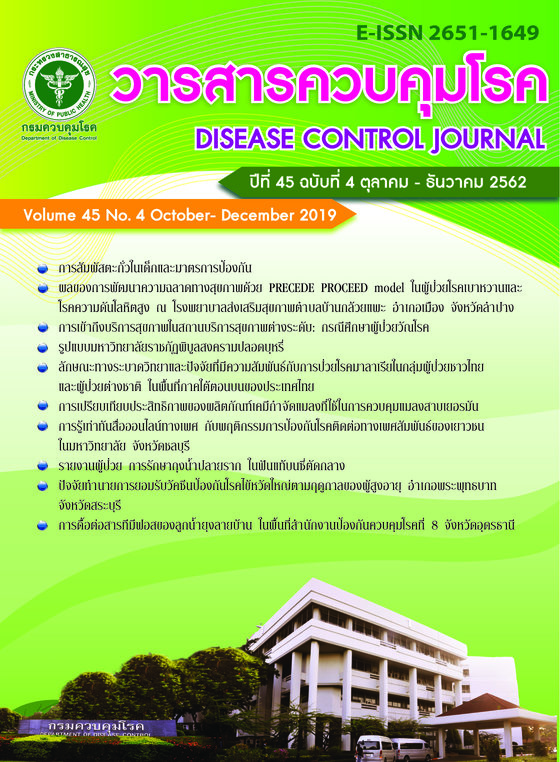Temephos resistance of Aedes aegypti larvae in the area covered by the Office of Disease Prevention and Control Region 8, Udon Thani
DOI:
https://doi.org/10.14456/dcj.2019.40Keywords:
resistance ratio, temephos, Aedes aegypti larvaeAbstract
The purpose of this study was to test temephos resistance of Aedes aegypti larvae in seven provinces covered by the office of Disease Prevention and Control Region 8, Udon Thani and the study was conducted between July-September 2018. Using a simple random sampling method, samples of Aedes aegypti larvae were collected from one representative village per province and the larval samples were looked after until they were in strong and normal conditions. The late third-stage and early fourth-stage larvae were selected for assay at the concentration of 0.0015-0.048 mg/L, which is in line with the recommendations by the World Health Organization (WHO). Data were analyzed using basic statistical methods and probit regression for LC50, as well as calculating for resistance ratio (RR). The results showed that the Bora-Bora strain of Aedes aegypti larvae tested under the concentration of 0.0015-0.048 mg/l had mortality rates of 13-100%, and the mortality rate of 100% at the concentration greater than or equal to 0.012 mg/L and the LC50 value was 0.003 mg/L. The local strains of Aedes aegypti larvae samples tested under the concentration 0.006-0.048 mg/L had mortality rates of 0-100%, the LC50 values were 0.011-0.037 mg/L and the temephos resistance ratios of 3.67-12.33. In conclusion, the Aedes aegypti larvae from Bung Kan province had the highest resistance to temephos, while moderate resistance to this chemical was found in larval samples from Nakhon Phanom, Loei, Sakon Nakhon, Nong Khai and Udon Thani provinces. Contrary to the above findings, larval samples from Nong Bua Lamphu province were found to be sensitive to temephos. The results of this study indicate that Aedes aegypti larvae from different locations had different resistance rates to temephos. The findings are useful for making decision with respect to the use of appropriate concentrations of temephos and time needed for controlling Aedes aegypti larvae populations based on the above mentioned temephos resistance rates. The area with higher temephos resistance ratios should take less time to control the Aedes aegypti larvae populations. In addition, temephos should be used when necessary so as to delay potential resistance of Aedes aegypti larvae to the chemical and temephos resistance should also be periodically monitored.
References
2. Saengtharatip S. Aedes aegypti-vector of dengue fever. In: Saengtharatip S, editor. Miscellaneous articles on dengue fever. Nonthaburi: Dengue Fever Control Office, Department of Communicable Disease Control, Ministry of Public Health; 2001. p. 30-4.
3.Saengtharatip S. Insecticides. In: Saengtharatip S, editor. Miscellaneous articles on dengue fever. Nonthaburi: Dengue Fever Control Office, Department of Communicable Disease Control, Ministry of Public Health; 2001. p. 89-97.
4. Pant CP, Self LS. Vector ecology and bionomics. In: Thongcharoen P, editor. Monograph on dengue/dengue haemorraghic fever. New Delhi: WHO Regional Office for South-East Asia; 1993. p. 121-38.
5. World Health Organization. Monitoring and managing insecticide resistance in Aedes mosquito populations. Interim guidance for entomologists. Geneva: World Health Organization; 2016.
6. World Health Organization. Guidelines for laboratory and field testing of mosquito larvicides [Internet]. Geneva: World Health Organization; 2005 [cited 2018 Jan 4]. 39 p. Available from: https://apps.who.int/iris/bitstream/10665/69101/1/WHO_CDS_WHOPES_GCDPP_2005.13.pdf
7. Sailugkum S, Kaewhanam J, Kunpakdee P, Laknamthiang S. The sensitivity of Aedes aegypti larvae to the concentration of temephos 0.02 mg/L Loei and Nongbualumphu Province, 2014. Journal of The Office of ODPC 7 Khon Kaen 2016;23:38-45.
8. Ya-oup K, Pimbueng A, Kulhong B, Soonchan P. Insecticides susceptible of Aedes aegypti in area responsibility of Office of Disease Prevention and Control 6 Khon Kaen, 2009. Journal of The Office of ODPC 6 Khon Kaen 2011;18:1-9.
9. Sessomboon P, Phothimol S. Susceptibility test of Aedes aegypti larvae to temephos, in Udon Thani Province, 2007. Journal of The Office of ODPC 6 Khon Kaen 2008;15:67-72.
10. Laithaveewat L, Ya-oup K, Phusub Y, Limviroj W. Study to determine temephos resistance of Aedes aegypti larvae in the upper northeast of Thailand, 2006. Journal of Vector Borne Disease 2010;7:19-20.
Downloads
Published
How to Cite
Issue
Section
License
Articles published in the Disease Control Journal are considered as academic work, research or analysis of the personal opinion of the authors, not the opinion of the Thailand Department of Disease Control or editorial team. The authors must be responsible for their articles.



.png)



